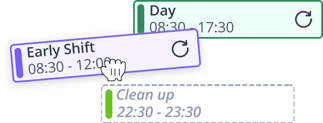Biometric timekeeping is reshaping how employers track employee hours. This guide explains the core technologies, the real benefits, the pitfalls to avoid, and how to roll it out responsibly.
What is biometric timekeeping?
Biometric timekeeping records attendance using unique physical or behavioural traits instead of PINs, badges, or paper timesheets. When employees clock in or out, a biometric device verifies identity from a stored template (not the raw fingerprint/face) and sends the punch to your time & attendance system. The result: fewer errors, fewer time-fraud opportunities (like buddy punching), and cleaner payroll data.
Common biometric identifiers
| Method | How it works | Typical use |
|---|---|---|
| Fingerprint | Matches ridge patterns to a stored template | Offices, retail, hospitality |
| Facial recognition | Maps facial geometry via camera | Contactless kiosks, mobile clock-ins |
| Iris | Authenticates from patterns in the coloured iris | Labs, defence, high-security sites |
| Voice | Verifies voiceprint & speech traits | Hands-free or remote scenarios |
| Hand geometry | Measures hand size/shape | Industrial environments |
How the tech works (in practice)
Fingerprint scanning
- Pros: Fast, affordable, widely supported
- Watch-outs: Dirty/wet fingers, gloves, or worn prints can increase failed matches; add sanitizer & cleaning, or provide an alternative method.
Facial recognition
- Pros: Touch-free, quick, good for gloved or dusty work
- Watch-outs: Configure liveness detection and routinely test for demographic bias; ensure adequate lighting and camera placement.
Iris/retina
- Pros: Extremely accurate, spoof-resistant
- Watch-outs: Higher cost and more specialized hardware—best reserved for regulated/high-security settings.
Benefits of biometric timekeeping
1) Eliminates buddy punching & time theft
Linking punches to a unique biometric template closes loopholes that inflate labour costs and distort productivity metrics.
2) Raises payroll accuracy
- Reduces missed punches and manual corrections
- Feeds clean hours to payroll for timely, correct pay
- Cuts disputes about start/finish times
3) Improves security & compliance
- Removes badge-sharing risk for restricted areas
- Creates auditable logs tied to verified identities
Challenges & considerations
Privacy & trust
- Be transparent about what you collect (templates, not raw images), why, how long you keep it, and who can access it.
- Offer a reasonable alternative for workers who can’t or won’t use biometrics (accessibility, religious, medical reasons)—and ensure no adverse treatment.
Cost & fit
- Budget for devices, software licences, installation, and support.
- Pilot in a representative location before scaling to validate throughput, failure rates, and user experience.
Integration
- Confirm real-time sync with your time & attendance, scheduling, and payroll stack.
- Require detailed event logs (enrolment, match, failure) and robust APIs.
Legal & regulatory snapshot (high level)
United States: Several states regulate biometrics. Illinois’ BIPA (among the strictest) requires written notice/consent, a public retention & destruction policy, and limits on disclosure; violations can trigger private lawsuits. Texas and Washington also regulate biometric identifiers. California treats biometrics as “sensitive personal information” under CPRA. Always check every state where you operate.
United Kingdom: Biometric data used to uniquely identify someone is “special category” under the UK GDPR/Data Protection Act 2018. You’ll need (1) a lawful basis under Art. 6 (e.g., legitimate interests) and (2) a valid Art. 9 condition (e.g., employment law obligations or substantial public interest with an appropriate policy). Consent in employment is often not the best basis due to power imbalance. A DPIA (data protection impact assessment) is usually expected.
⚠️This is general information, not legal advice—consult counsel for your jurisdictions.
Privacy-by-design checklist
- Minimise data: Store templates, not raw images; avoid cloud storage of raw biometrics.
- Security: Encrypt in transit/at rest; use HSM/secure enclaves where possible; enable role-based access and audit logs.
- Retention: Keep templates only as long as necessary (e.g., delete upon termination + defined period).
- Transparency: Clear policy, notices, and signage; employee access requests handled promptly.
- Accuracy & bias: Vendor due diligence (e.g., independent testing), monitor false accept/reject rates, and remediate disparities.
Implementation playbook
- Define the use case: Attendance only (not broad surveillance). Document the legitimate interest/business need.
- Run a DPIA/PIA: Identify risks, mitigations, and your lawful basis; involve works councils/unions where applicable.
- Select devices & vendor: Require liveness detection, template storage, detailed logs, strong APIs, and a clear DPA (data processing agreement).
- Pilot & measure: Track throughput, failure rates, user satisfaction, and exception volumes.
- Create policies & alternatives: Publish retention/destruction schedules; provide non-biometric options without penalty.
- Train & communicate: Short how-to videos, FAQs, and support paths reduce friction and missed punches.
- Monitor & audit: Review accuracy, appeals, and access logs; refresh your DPIA and policy annually or on change.
Integrating biometrics with your WFM stack
Time & attendance
- Real-time punch capture reduces manual edits and payroll delays.
Payroll
- Accurate, approved hours flow straight into the pay run; fewer adjustments and disputes.
Scheduling
- Live visibility of late/no-shows; historical data improves forecasting and cost control.
How Shiftbase helps
Shiftbase connects with biometric devices to centralise time tracking, scheduling, and absence management:
- Sync biometric punches in real time
- Flag missed punches/late arrivals automatically
- Export payroll-ready hours with audit trails
✅ Ready to modernise attendance—and do it responsibly? Try Shiftbase free for 14 days.

- Easily clock in and out
- Automatic calculation of surcharges
- Link with payroll administration



